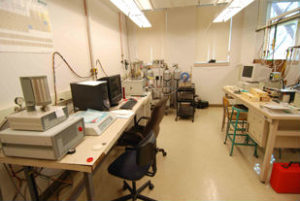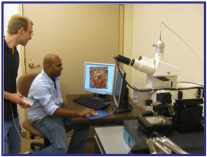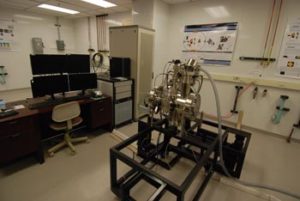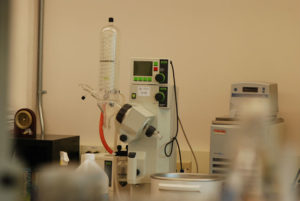Facilities
CCAC Facilities
***This page is under construction. We are currently working on more detailed documentation of the CCAC facilities.
Please contact ragland@mines.edu with specific questions.***


Electron Microscopy Laboratory

The Electron Microscopy facility, which also houses diffraction and optical spectroscopy capabilities, provides instrumentation for high-resolution characterization of materials, as well as all the equipment needed for sample preparation. Two highly experienced technical staff assist with training of users and maintenance of equipment including:
- FEI Co. Helios 600i dual column FIB / FESEM capable of 0.7 nm spatial resolution (SEM) and 65 nA beam currents (FIB). Equipped with an Omniprobe 400 for in-situ specimen preparation and manipulation, electron backscatter diffraction (EBSD), and energy dispersive x-ray spectroscopy (EDS)
- JEOL JSM-7000F Field Emission Scanning Electron Microscope with EDAX Genesis EDS, TSL EBSD and Nabity NPGS e-beam lithography (Acquisition of this system was supported by NSF Award# 0520386)
- JEOL JSM6320F FESEM with cold cathode field emission electron source and EDAX energy dispersive spectrometer
- Philips CM12 Transmission Electron Microscope with EDAX EDS
- Philips CM200 Ultra Twin Transmission Electron Microscope with a LaB6 thermionic electron source; also equipped with an SYS digital imaging system and EDS
- Philips X’Pert XRD with 2011 version of ICDD
- A unique in the world Dynamic Atom Probe laboratory for time-resolved characterization of atomic scale chemical mapping, consisting of a Cameca LEAP 4000X Si laser pulsed APT and a custom APT system paired with an Orsay e-Clipse II UHV STEM capable of 2 nm resolution. The electron optical system is coupled with a diffraction pattern collection system, allowing for ultrafast pattern collection and ns temporal resolution.
Thermal Lab

Furnace


Nanoindenter
Fuel Cells
| HH371 is home to a number of ceramic fuel cell test stations used by the Advanced Energy Materials Laboratory. The test stations provide heating up to 900°C, access to a variety of gases, advanced electrochemical measurements, and gas chromatography and mass spectrometry capabilities for exhaust gas analysis. |
  |
Dry Nitrogen glove box
| Dry Nitrogen Glove Box: This equipment allows for the conduction of experiments in non-atmospheric conditions. Typically, it is used to perform experiments with controlled humidity conditions. However, other non-atmospheric conditions are possible. |  |
| Tensile Test Fixture: This fixture has a small form factor which allows it to be used in the dry nitrogen glove box, for tests at non-atmospheric conditions, and in the environmental scanning electron microscope (ESEM), for tests where visualizing in-situ loading response at the microscopic level is valuable. |  |
Tensile Test Fixture
CONFOCAL RAMAN LAB

Atom Probe Tomography Lab

The Dynamic Atom Probe Laboratory, for which instruments were funded via an NSF MRI Development grant in 2010. The instruments consist of a Cameca LEAP 4000XSi laser pulsed APT and a custom APT system paired with an Orsay e-Clipse || UHV STEM capable of 2 nm resolution. The electron optical system is coupled with a diffraction pattern collection system, allowing for ultrafast pattern collection and ns temporal resolution.
http://atomprobe.mines.edu/
Synthesis and Processing
Rotovap
Particle

3D Printers


Rheology
The flow properties of colloidal ceramic suspensions need to be very well understood in order to use them for fabrication methods such as tape casting and 3D printing. Our rheological equipment allows us to study the flow and viscoelastic properties of ceramic suspensions that are developed for these applications. Shear thinning behavior is often a requirement for 3D printing, for example, and therefore there must be a very good understanding of how these suspensions are affected by the sacrificial organic additives that are used for producing proper suspension rheologies. Plots of shear stress vs shear rate, viscosity vs shear rate, and many more, can be obtained using this equipment and assists the student in the understanding of how our ceramic materials will flow during fabrication processes. Shown here is the our Anton Paar Modular Compact Rheometer (MCR) 92, with a concentric cylinder (cup and bob) setup for measuring low to medium viscosity suspensions

SIMS
3D printer
| The Formlabs Form2 SLA 3D Printer is an inverted stereolithography printer that polymerizes a liquid photocurable resin with a laser to generate parts. Note: this printer is not on FOM. |
 |
Long Distance Microscope
